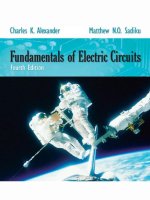Charles k alexander,matthew n o sadiku fundamentals of electric circuits instructor solutions manual mcgraw hill (2013)
Bạn đang xem bản rút gọn của tài liệu. Xem và tải ngay bản đầy đủ của tài liệu tại đây (10.45 MB, 1,972 trang )
W
ith its objective to present circuit analysis in a manner that is clearer, more interesting, and easier to
understand than other texts, Fundamentals of Electric Circuits by Charles Alexander and Matthew Sadiku
has become the student choice for introductory electric circuits courses.
FiFth
Edition
FiFt h Edition
Building on the success of the previous editions, the fifth edition features the latest updates and advances in the
field, while continuing to present material with an unmatched pedagogy and communication style.
Fundamentals of
Pedagogical Features
Matched Example Problems and Extended Examples. Each illustrative example is immediately followed by a
practice problem and answer to test understanding of the preceding example. one extended example per
chapter shows an example problem worked using a detailed outline of the six-step method so students can
see how to practice this technique. Students follow the example step-by-step to solve the practice problem
without having to flip pages or search the end of the book for answers.
■
Comprehensive Coverage of Material. not only is Fundamentals the most comprehensive text in terms of
material, but it is also self-contained in regards to mathematics and theory, which means that when students
have questions regarding the mathematics or theory they are using to solve problems, they can find answers to
their questions in the text itself. they will not need to seek out other references.
■
Computer tools. PSpice® for Windows is used throughout the text with discussions and examples at the end of
each appropriate chapter. MAtLAB® is also used in the book as a computational tool.
■
new to the fifth edition is the addition of 120 national instruments Multisim™ circuit files. Solutions for almost
all of the problems solved using PSpice are also available to the instructor in Multisim.
■
We continue to make available KCidE for Circuits (a Knowledge Capturing integrated design Environment for
Circuits).
■
An icon is used to identify homework problems that either should be solved or are more easily solved using
PSpice, Multisim, and/or KCidE. Likewise, we use another icon to identify problems that should be solved or are
more easily solved using MAtLAB.
Teaching Resources
McGraw-hill Connect® Engineering is a web-based assignment and assessment platform that gives students the
means to better connect with their coursework, with their instructors, and with the important concepts that they
will need to know for success now and in the future. Contact your McGraw-hill sales representative or visit www.
connect.mcgraw-hill.com for more details.
Electric Circuits
INSTRUCTOR
SOLUTIONS
MANUAL
MD DALIM 1167970 10/30/11 CYAN MAG YELO BLACK
■
Fundamentals of
Problem-Solving Methodology. A six-step method for solving circuits problems is introduced in Chapter 1 and
used consistently throughout the book to help students develop a systems approach to problem solving that
leads to better understanding and fewer mistakes in mathematics and theory.
Electric Circuits
■
the text also features a website of student and instructor resources. Check it out at www.mhhe.com/alexander.
Alexander
Sadiku
Charles K. Alexander | Matthew n. o. Sadiku
Chapter 1, Solution 1
(a) q = 6.482x1017 x [-1.602x10-19 C] = –103.84 mC
(b) q = 1. 24x1018 x [-1.602x10-19 C] = –198.65 mC
(c) q = 2.46x1019 x [-1.602x10-19 C] = –3.941 C
(d) q = 1.628x1020 x [-1.602x10-19 C] = –26.08 C
Chapter 1, Solution 2
(a)
(b)
(c)
(d)
(e)
i = dq/dt = 3 mA
i = dq/dt = (16t + 4) A
i = dq/dt = (-3e-t + 10e-2t) nA
i=dq/dt = 1200 cos 120 t pA
i =dq/dt = e 4t (80 cos 50 t 1000 sin 50 t ) A
Chapter 1, Solution 3
(a) q(t) i(t)dt q(0) (3t 1) C
(b) q(t) (2t s) dt q(v) (t 2 5t) mC
(c) q(t) 20 cos 10t / 6 q(0) (2sin(10t / 6) 1) C
10e -30t
q(t) 10e sin 40t q(0)
( 30 sin 40t - 40 cos t)
(d)
900 1600
e - 30t (0.16cos40 t 0.12 sin 40t) C
-30t
Chapter 1, Solution 4
q = it = 7.4 x 20 = 148 C
Chapter 1, Solution 5
10
1
t 2 10
q idt tdt
25 C
2
4 0
0
Chapter 1, Solution 6
(a) At t = 1ms, i
dq 30
15 A
dt
2
(b) At t = 6ms, i
dq
0A
dt
(c) At t = 10ms, i
dq 30
–7.5 A
dt
4
Chapter 1, Solution 7
25A,
dq
i
- 25A,
dt
25A,
0t2
2t6
6t8
which is sketched below:
Chapter 1, Solution 8
q idt
10 1
10 1 15 μC
2
Chapter 1, Solution 9
1
(a) q idt 10 dt 10 C
0
3
5 1
q idt 10 1 10
5 1
0
(b)
2
15 7.5 5 22.5C
5
(c) q idt 10 10 10 30 C
0
Chapter 1, Solution 10
q = it = 10x103x15x10-6 = 150 mC
Chapter 1, Solution 11
q= it = 90 x10-3 x 12 x 60 x 60 = 3.888 kC
E = pt = ivt = qv = 3888 x1.5 = 5.832 kJ
Chapter 1, Solution 12
For 0 < t < 6s, assuming q(0) = 0,
t
t
0
0
q (t ) idt q (0 ) 3tdt 0 1.5t 2
At t=6, q(6) = 1.5(6)2 = 54
For 6 < t < 10s,
t
t
6
6
q (t ) idt q (6 ) 18 dt 54 18 t 54
At t=10, q(10) = 180 – 54 = 126
For 10
t
10
10
q (t ) idt q (10 ) ( 12)dt 126 12t 246
At t=15, q(15) = -12x15 + 246 = 66
For 15
q (t ) 0 dt q (15) 66
15
Thus,
1.5t 2 C, 0 < t < 6s
18 t 54 C, 6 < t < 10s
q (t )
12t 246 C, 10 < t < 15s
66 C, 15 < t < 20s
The plot of the charge is shown below.
140
120
100
q(t)
80
60
40
20
0
0
5
10
t
15
20
Chapter 1, Solution 13
(a) i = [dq/dt] = 20πcos(4πt) mA
p = vi = 60πcos2(4πt) mW
At t=0.3s,
p = vi = 60πcos2(4π0.3) mW = 123.37 mW
(b) W =
W = 30π[0.6+(1/(8π))[sin(8π0.6)–sin(0)]] = 58.76 mJ
Chapter 1, Solution 14
1
(a) q idt 0.02 1 - e -0.5t dt 0.02 t 2e -0.5t
0
(b)
1
0
0.02 1 2e -0.5 2 = 4.261 mC
p(t) = v(t)i(t)
p(1) = 10cos(2)x0.02(1–e–0.5) = (–4.161)(0.007869)
= –32.74 mW
Chapter 1, Solution 15
0.006 2t
q idt 0.006e dt
e
0
(a)
2
2
2
- 2t
0
0.003 e 1
2.945 mC
(b)
-4
10di
0.012e - 2t (10) 0.12e - 2t V this leads to p(t) = v(t)i(t) =
dt
(-0.12e-2t)(0.006e-2t) = –720e–4t µW
v
3
(c) w pdt -0.72 e
0
720 -4t 6
dt
e 10 = –180 µJ
4
0
3
- 4t
Chapter 1, Solution 16
(a)
30t mA, 0 < t <2
i (t )
120-30t mA, 2 < t<4
5 V, 0 < t <2
v(t )
-5 V, 2 < t<4
150t mW, 0 < t <2
p(t )
-600+150t mW, 2 < t<4
which is sketched below.
p(mW)
300
1
2
-300
(b) From the graph of p,
4
W pdt 0 J
0
4
t (s)
Chapter 1, Solution 17
p=0
-205 + 60 + 45 + 30 + p 3 = 0
p 3 = 205 – 135 = 70 W
Thus element 3 receives 70 W.
Chapter 1, Solution 18
p 1 = 30(-10) = -300 W
p 2 = 10(10) = 100 W
p 3 = 20(14) = 280 W
p 4 = 8(-4) = -32 W
p 5 = 12(-4) = -48 W
Chapter 1, Solution 19
I = 8 –2 = 6 A
Calculating the power absorbed by each element means we need to find vi for
each element.
p 8 amp source = –8x9 = –72 W
p element with 9 volts across it = 2x9 = 18 W
p element with 3 bolts across it = 3x6 = 18 W
p 6 volt source = 6x6 = 36 W
One check we can use is that the sum of the power absorbed must equal zero
which is what it does.
Chapter 1, Solution 20
p 30 volt source = 30x(–6) = –180 W
p 12 volt element = 12x6 = 72 W
p 28 volt e.ement with 2 amps flowing through it = 28x2 = 56 W
p 28 volt element with 1 amp flowing through it = 28x1 = 28 W
p the 5Io dependent source = 5x2x(–3) = –30 W
Since the total power absorbed by all the elements in the circuit must equal zero,
or 0 = –180+72+56+28–30+p into the element with Vo or
p into the element with Vo = 180–72–56–28+30 = 54 W
Since p into the element with Vo = V o x3 = 54 W or V o = 18 V.
Chapter 1, Solution 21
p 60
0.5 A
v 120
q = it = 0.5x24x60x60 = 43.2 kC
N e qx6.24 x1018 2.696 x1023 electrons
p vi
i
Chapter 1, Solution 22
q = it = 40x103x1.7x10–3 = 68 C
Chapter 1, Solution 23
W = pt = 1.8x(15/60) x30 kWh = 13.5kWh
C = 10cents x13.5 = $1.35









